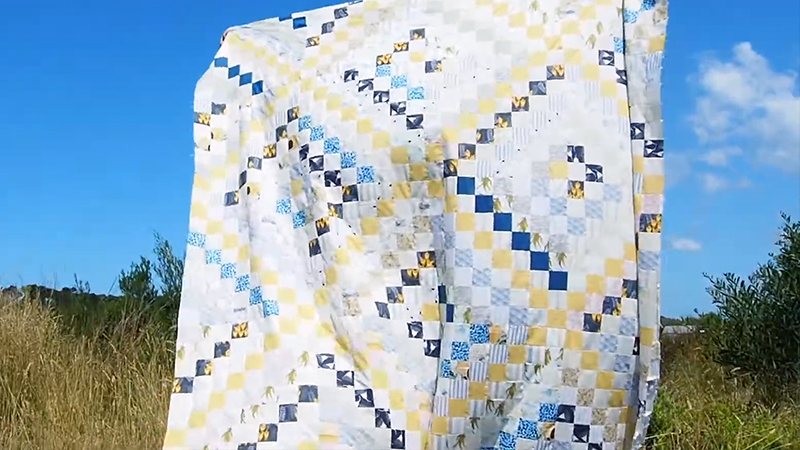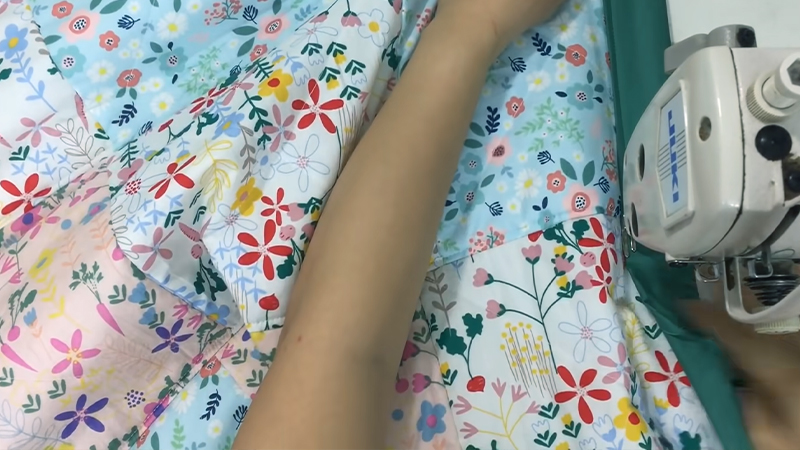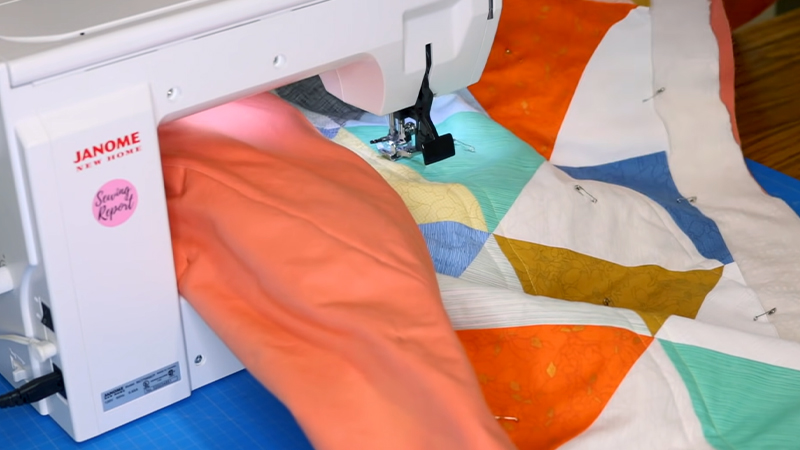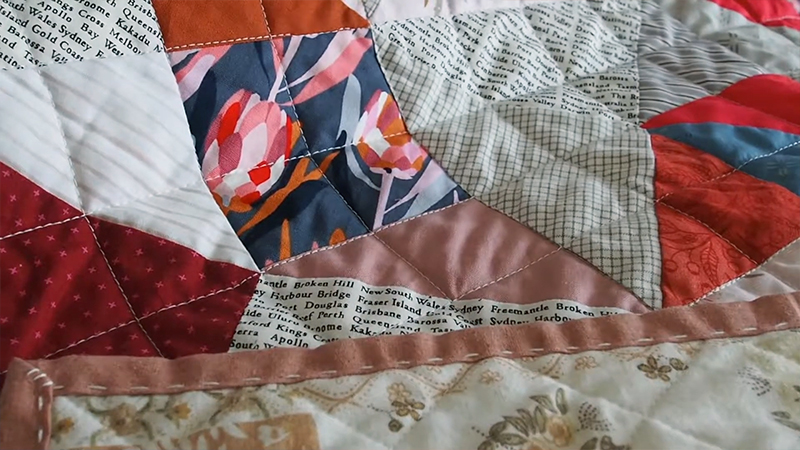Creating a quilt is a labor of love, a craft that combines artistry, precision, and dedication.
Yet, how long it takes to make a quilt is as varied as the quilts. The intricacy of the design, the size of the quilt, and the chosen techniques all play a role.
The skill level and available time further shape the timeline. Each approach carries its temporal footprint, from the meticulous hand-stitching of a cherished heirloom to the precision of machine-quilting for efficiency.
This exploration will unravel the factors influencing quilt-making, shedding light on the artful tapestry of time and creativity.

How Long Does It Take To Make a Quilt?
The time it takes to make a quilt can vary significantly depending on several factors, including the design’s complexity, size, skill level, and the chosen quilting techniques.
Quilting is a beautiful and intricate craft that requires patience, attention to detail, and a love for the process.
Here, we’ll explore the various stages of quilt-making and provide a general overview of how long it might take to complete a quilt.
Design and Planning
The design phase is where creativity takes center stage. Quilters may sketch patterns or browse books, magazines, or online resources for inspiration.
Factors like color choices and fabric combinations are crucial in bringing the design to life. This phase can involve multiple iterations and adjustments until the quilter is satisfied with the envisioned quilt.
Fabric Selection
Choosing fabrics can be a delightful yet time-consuming task. Quilters carefully consider color palettes, prints, and fabric types.
They might lay out swatches, mix, match, and even seek input from fellow quilters or friends. Each fabric selection contributes to the overall aesthetic and mood of the quilt.
Cutting
Precision is critical in this stage. Quilters measure and cut fabric pieces according to the chosen pattern. This process demands attention to detail and a steady hand.
Even experienced quilters can spend hours meticulously cutting fabric to ensure accuracy and uniformity.
Piecing
Assembling the quilt blocks requires a combination of sewing skills and patience. Quilters align seams, match points, and sew precisely to ensure the blocks fit together seamlessly.
Some intricate patterns involve techniques like appliqué or foundation piecing, which can extend the time needed for this phase.
Quilting
This stage is where the layers come together to create a cohesive quilt. Hand quilting involves the slow, rhythmic process of stitching by hand, which can be a meditative and time-intensive endeavor.
Machine quilting, while faster, still demands skill in maneuvering the quilt through the machine. Long-arm quilting, often done by professionals, offers efficiency for larger projects.
Binding
Applying the binding is the finishing touch that frames the quilt. Quilters carefully attach strips of fabric around the edges, creating a clean and polished look. Mitered corners and neatly stitched bindings testify to a quilter’s attention to detail.
Finishing Touches
Some quilters enjoy adding unique elements to their quilts, such as embroidery, beadwork, or fabric painting. These embellishments can be time-consuming but add a personal touch and enhance the overall visual appeal.
Quality Control
Taking time to inspect the quilt ensures that it meets the quilter’s standards for craftsmanship. This step may involve scrutinizing seams, checking for loose threads, and guaranteeing the quilt lies flat and square.
Factors Affecting Quilting Time

Various factors can influence the time it takes to complete a quilting project. Quilting is a craft involving multiple stages, and each factor can impact the overall timeline.
Here are some key factors that affect the time required for quilting:
Design Complexity
The complexity of the design is a pivotal factor in determining how long it will take to complete a quilt. Simple designs with large, straightforward pieces may be assembled relatively quickly.
In contrast, intricate designs featuring numerous small elements demand a more extensive investment of time.
Quilt Size
The size of the quilt directly impacts the amount of time needed for completion. More miniature quilts, such as baby quilts or wall hangings, can be finished in a shorter period than larger ones like queen or king-sized quilts.
Larger quilts require more fabric, more cutting, and longer quilting time.
Quilting Technique
The chosen quilting technique is a significant determinant of the overall time investment. Hand quilting, while producing stunning results, is a meticulous, time-consuming process.
The quilter creates each stitch by hand, resulting in a beautifully textured finish but necessitating a longer timeframe. Machine quilting is typically faster but still requires skill and precision.
Long-arm quilting, performed by professionals with specialized equipment, can substantially speed up the quilting phase.
Quilter’s Skill Level
Experience plays a critical role in determining how long it takes to complete a quilt. An experienced quilter is likely to work more efficiently, having honed their skills in accurate cutting, precise piecing, and effective quilting.
They are also better equipped to troubleshoot and rectify any mistakes or unforeseen challenges that may arise during the process.
Preparation Time
The time spent on preparation tasks is often underestimated but is essential for a smooth quilting process.
This includes selecting and coordinating fabrics, washing and ironing them to ensure they’re free of dirt and sizing, and carefully cutting pieces to precise measurements.
Well-organized quilters who plan can streamline this stage, contributing to a more efficient overall timeline.
Pattern Familiarity
Familiarity with a specific quilt pattern or style can significantly impact the time required for completion.
Quilters who have previously worked on similar designs or have a deep understanding of the chosen pattern will often progress more swiftly. They can anticipate potential challenges and navigate the piecing process with greater confidence.
Quilting Tools and Equipment
Having the right tools and equipment at one’s disposal is crucial for efficient quilting.
High-quality rotary cutters, well-maintained sewing machines, and a spacious cutting area can expedite tasks like cutting and piecing. Well-functioning tools not only save time but also enhance the overall quilting experience.
Availability of Time
A fundamental factor is the amount of time a quilter can allocate to their project regularly.
Quilters with more available time may progress through the stages more quickly, while those with limited time might find their projects extending over a more extended period.
Time availability is a practical consideration that can influence the overall timeline.
Complexity of Techniques
Quilts incorporating advanced techniques, such as appliqué, paper piecing, or curved piecing, generally take longer to complete.
These techniques require additional attention to detail, precision, and sometimes a learning curve for new quilters.
While they can result in stunning, intricate quilts, they often require more time investment.
Quilting Goals and Deadlines
Quilters working with specific goals or deadlines, such as creating a quilt for a special occasion or entering a quilt show, may need to manage their time more rigorously.
Meeting a set deadline requires careful planning, efficient execution, and sometimes making choices, prioritizing completion over additional details or complexity.
Hand vs. Machine Work
The choice between handwork and machine work is a significant factor in determining quilting time. For example, hand-quilting is a traditional method that involves creating tiny, even stitches by hand.
While this technique produces a beautiful, time-intensive finish, machine quilting, which utilizes a sewing machine, is generally faster.
Customization and Embellishments
Adding custom elements or embellishments to a quilt can significantly extend the time required for completion.
Tasks like intricate embroidery, appliqué work, or additional design elements demand a meticulous approach and careful attention to detail.
While these embellishments can enhance the final product, they require a more substantial time investment.
Quilting Community and Support
Being part of a quilting community or having access to quilting classes and workshops can impact the learning curve and the overall time spent on a project.
Quilters with a support system can learn new techniques more quickly, receive guidance on challenging aspects, and benefit from shared tips and tricks that streamline the process.
Availability of Quilting Space
A dedicated quilting space with sufficient room for cutting, piecing, and quilting can significantly impact efficiency.
A well-organized workspace with a large cutting table and ample storage can make the process more streamlined compared to working in a cramped or disorganized environment.
How Can You Estimate How Long It Will Take Time to Make Different-Sized Quilts?

Estimating the time it will take to make different-sized quilts can be a helpful way to plan your quilting projects. While there is no definitive formula, your guidelines can serve as a starting point for creating rough estimates.
However, it’s essential to remember that these calculations are approximate and can vary based on individual factors and preferences.
Here’s a more detailed breakdown of how to use these guidelines:
Estimating Piecing Time
- Measure the size of your quilt top in square inches (length x width).
- Multiply the total square inches by 0.75 to estimate the number of hours it will take you to piece the top.
- This calculation assumes that you can piece one square inch of fabric in approximately 45 seconds, which accounts for selecting fabric, cutting, piecing, and pressing.
Estimating Quilting Time
- Measure the size of your quilt in square inches (length x width).
- Multiply the total square inches by 0.25 to estimate the number of hours it will take you to quilt the layers together.
- This calculation assumes you can quilt one square inch of fabric in approximately 15 seconds, accounting for machine setup, quilting speed, and breaks.
Additional Time for Binding and Finishing
- Adding extra time for binding, labeling, and finishing touches is a good practice. Adding 10% of the estimated time for these final steps is a reasonable guideline.
- For example, if your estimated piecing time is 20 hours, you can add 2 hours (10% of 20 hours) for binding and finishing.
Practical Tips for Speeding up the Quilting Process

Speeding up the quilting process requires efficient techniques and intelligent planning.
Here are some practical tips to help you quilt more quickly while maintaining quality:
Plan Your Project in Advance
Take the time to sketch your design, choose fabrics, and plan your layout.
Consider creating a mock-up or digital representation to visualize the finished quilt. This detailed planning will save you time and reduce uncertainty during quilting.
Pre-cut Fabric Pieces
Invest time upfront to accurately cut all the fabric pieces you’ll need for your quilt. This can be done using templates, rulers, and a rotary cutter.
Having pre-cut pieces on hand streamlines the piecing process and eliminates the need for constant cutting interruptions.
Organize Your Workspace
Designate specific areas for cutting, piecing, pressing, and quilting. Keep tools, notions, and fabrics neatly organized and within arm’s reach.
An organized workspace minimizes time spent searching for supplies and maximizes your efficiency.
Chain Piecing
Embrace the chain piecing technique by sewing multiple pieces in a continuous chain without stopping to cut the threads.
This method reduces thread changes, minimizes starts and stops, and allows for a more efficient workflow, especially when piecing numerous blocks.
Efficient Pressing
Use an efficient pressing technique, such as the “press to one side” method, to reduce the time spent at the ironing board.
Avoid unnecessary ironing by pressing seams only when necessary, and use a hot iron for crisp results.
Batch Processing
Group similar tasks together and complete them in batches. For instance, cut out all pieces for multiple blocks simultaneously, then move on to the piecing stage.
This approach minimizes the time spent transitioning between tasks and keeps your workflow consistent.
Utilize Quilting Tools
Invest in high-quality quilting tools that are both durable and easy to use. A reliable sewing machine, sharp rotary cutter, clear quilting rulers, and a self-healing cutting mat are essential tools that enhance accuracy and efficiency.
Accurate Seams
Take the time to measure and sew precise 1/4-inch seam allowances. Consistent seam allowances ensure that pieces fit together accurately, reducing the need for adjustments and re-sewing.
Consider Simple Quilting Patterns
Opt for quilting designs that are straightforward to execute, especially if speed is a priority. Basic patterns can be just as stunning and are often quicker to complete than intricate designs.
Chain Basting
When layering the quilt sandwich, use the chain basting technique to insert safety pins at regular intervals without stopping. This continuous process is faster and more efficient than placing each pin individually.
Outsource Quilting Services
For complex or large quilts, consider enlisting the services of a professional long-arm quilter. They have specialized equipment that can complete the quilting process in a fraction of the time it might take you.
Set Goals and Deadlines
Establish clear, realistic goals and set deadlines for your quilting projects. This provides structure and motivation to work efficiently. Break down larger projects into smaller milestones to track progress.
Practice and Skill Building
Continuously work on honing your quilting skills. Practice precision piecing, explore new techniques, and seek opportunities for skill improvement. As you become more proficient, you’ll naturally become faster.
Limit Seam Ripping
While striving for accuracy is essential, avoid the temptation to rip out every tiny imperfection obsessively. Evaluate whether minor flaws will be noticeable in the final quilt and prioritize progressing with the project.
Stay Organized with Labels and Notes
Label fabric pieces and keep detailed notes about the assembly process. This prevents mistakes and saves time on rework caused by fabric mix-ups or assembly confusion.
FAQs
How long does it typically take to make a small quilt, like a baby?
The time to make a small quilt, such as a baby quilt, can vary, but it often ranges from a few days to a few weeks for a moderately experienced quilter.
What factors influence the time required to make a quilt?
Factors include the quilt’s size, complexity of design, chosen quilting technique (hand or machine), the quilter’s skill level, and the availability of dedicated time.
Is hand-quilting more time-consuming than machine-quilting?
Yes, hand-quilting is generally more time-intensive due to the meticulous nature of creating stitches by hand. Machine quilting is faster but offers a different aesthetic.
Can I complete a quilt in a weekend?
Completing a quilt on a weekend is possible for small, simple designs with much dedicated time. However, larger or more intricate quilts typically require more time and planning.
What’s the quickest way to speed up the quilt-making process?
Consider efficient techniques like chain piecing, pre-cutting fabric pieces, and outsourcing quilting services to professionals with long-arm machines to expedite quilt-making.
Wrap Up
In the realm of quilt-making, time dances with creativity, craftsmanship, and devotion. Each quilt carries a unique narrative, spun through patient stitches and thoughtful design choices.
From the swift hum of a sewing machine to the measured cadence of hand-quilting, time is an ever-present companion in this cherished craft.
As we unravel the intricacies of quilt-making, it becomes evident that there is no one-size-fits-all answer to how long it takes to create a quilt. Instead, it is a journey marked by personal style, skill, and the ebb and flow of time itself.
Ultimately, the process is a testament to the quilter’s artistry, yielding a tapestry of warmth, comfort, and creativity.
Leave a Reply